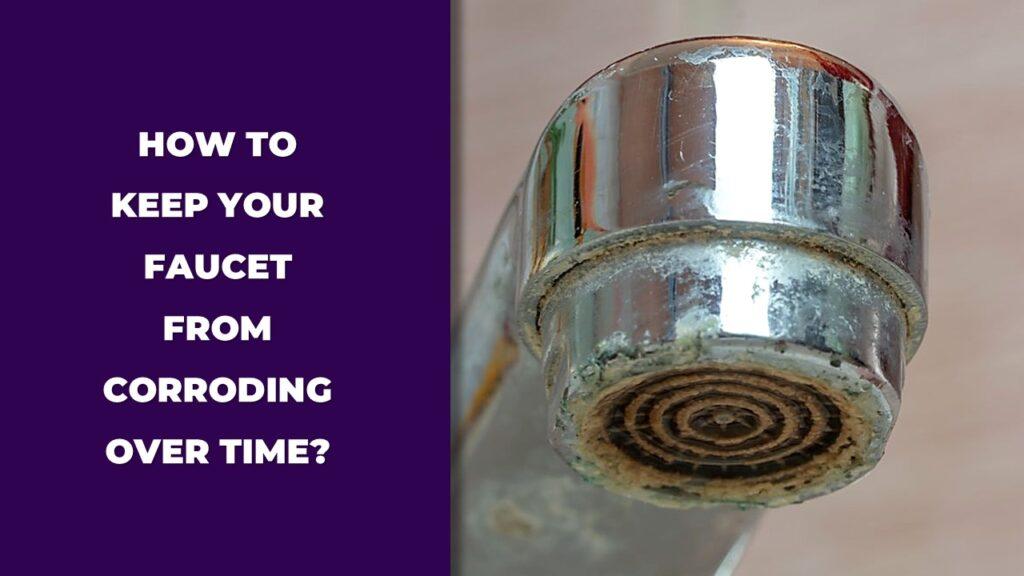
To keep your faucet from corroding over time, you’ve got to do a few things right. Wipe it down with a soft cloth and a bit of mild soap every now and then. Don’t just leave water sitting on it, dry it off after use, because moisture’s what gets it.
If you’ve got hard water, that can leave spots and buildup, so clean that up with a little diluted vinegar now and then. And if you’re really thinking ahead, go for faucets made of corrosion-resistant materials like stainless steel or treated brass. Those hold up a lot better in the long run. Oh, and keep an eye out for leaks. They can sneak up on you and make things worse.
In this article, we’ll share tips on cleaning the right way, how to handle hard water, why good materials matter, and a few easy tricks for making sure your faucet lasts. It’s not complicated, just stuff that helps. Let’s get into it.
What Is Faucet Corrosion?
Faucet corrosion is just the metal in your faucet breaking down over time, mostly because of water, air, and minerals hanging around. It shows up as rust, stains, those little pits you can feel, or the finish flaking off. You know when you touch your faucet and it just feels off, like it’s not as smooth or shiny anymore? That’s corrosion sneaking in.
It’s kind of like leaving your bike outside during the rainy season—you leave it out there, it’s gonna rust. The same thing happens to faucets. They’re in wet spots like the kitchen or bathroom, always getting splashed with water, and if you don’t wipe them dry or clean them once in a while, the metal just reacts. Over time, it starts wearing down, and you’ll see those spots or rough patches. It’s your faucet’s way of saying, “Hey, I’m not doing so good here.”
Why Does Faucet Corrosion Occur Over Time?
So why does a faucet even corrode in the first place? Well, it’s because water, air, and minerals slowly react with the metal. Every time water splashes on the faucet, little droplets stick around. And if you don’t wipe it down, that water just sits there, doing its thing. After a while, it starts eating away at the surface, and before you know it, you’ve got rust spots.
Now, if you have hard water—meaning water loaded with minerals like calcium and magnesium—it’s a whole other problem. Those minerals leave behind that white, chalky stuff you sometimes see on faucets. It builds up, and if you ignore it, the finish starts to get rough, and the faucet just looks tired.
Humidity makes it worse, especially in bathrooms or kitchens where there’s a lot of steam. If you don’t have good ventilation, the moisture hangs in the air, clings to the faucet, and speeds up the corrosion. Once tiny pits form, they hold even more water, and that just kicks off a cycle of more damage.
And then you’ve got cleaning products. Some of them are just too strong, like bleach or ammonia. They wear down the protective coating on the faucet. When that happens, the bare metal underneath is exposed, and it’s like giving corrosion a big green light.
Leaks? Yep, they’re another problem. Even a slow drip from the faucet or a tiny leak under the sink can keep parts of your faucet wet for way too long. Corrosion loves that. If you don’t fix leaks, they just make things worse.
Signs Your Faucet Is Starting to Corrode
You’ll know your faucet’s starting to corrode when you spot little rust spots or stains. It might look a bit dull or patchy compared to when it was new. If you touch it and it feels rough in spots, that’s another sign something’s up.
Here’s a list of things to watch for:
- Rust spots, usually reddish-brown, show up near the base or spout.
- White, chalky buildup that doesn’t just wipe off—that’s minerals.
- The faucet’s finish is flaking off or peeling in spots.
- The color looks faded or uneven.
- Tiny pits or little holes form on the surface.
- Water is dripping from places like under the handles or around the base.
- Handles feel stiff or hard to turn—corrosion can mess up the moving parts too.
If you see any of this, it’s a good idea to take action. The longer you wait, the worse it’ll get, and trust me, a little work now is a lot better than having to replace the whole faucet later.
8 Proven Ways to Keep Your Faucet From Corroding Over Time
Here are the 8 proven ways to keep your faucet from corroding:
- Pick the right material when buying a faucet
- Clean it often and be gentle with it
- Use protective coatings to give it a shield
- Keep the area dry and reduce humidity
- Deal with hard water problems
- Fix any leaks as soon as you spot them
- Clean the aerators and small parts
- Avoid using harsh chemicals or rough tools
Keeping your faucet in good shape isn’t rocket science, but it does take a bit of care. Let’s go through each of these steps, one by one, so you know what to do to make sure your faucet lasts longer without getting all rusty or worn out.
1. Choose The Right Faucet Material
If you’re getting a new faucet, the material really matters, just like other household items like an oven. Stainless steel is a solid choice because it doesn’t rust easily. Treated brass is another good option, and it looks nice too. Some faucets are chrome-plated, which can help them last, but if the chrome chips off, you’ve got a problem. So when you’re buying, check what it’s made of. A cheap faucet made of weak metal is more likely to corrode no matter how careful you are.
2. Clean Your Faucet Properly (And Gently)
Wiping down your faucet once in a while helps more than you’d think. Use a soft cloth, not a scrubber, and a bit of mild soap. Nothing fancy, just regular dish soap works. After you clean it, dry it off. That part’s important—don’t leave water sitting on it. A quick wipe after each use helps stop those water spots and stains from forming.
3. Apply Protective Coatings
You can give your faucet an extra layer of protection by using a clear sealer or wax. It’s kind of like putting sunscreen on your skin before heading outside—it gives the faucet a little shield against water and air. Reapplying the coating every few months keeps it going strong. Some people do this every three to six months, depending on how much water splashes around.
4. Control Humidity Around Your Faucet
Bathrooms and kitchens are humid places. If there’s no exhaust fan, moisture can hang around and mess with your faucet. So if you can, crack a window or turn on a fan when you’re cooking or taking a hot shower. Wipe down any moisture you see on the faucet, sink, or countertop. The less moisture, the better your faucet will hold up.
5. Address Hard Water Problems
Hard water can be a real pain. If you’ve got white spots or chalky buildup on your faucet, that’s a sign of hard water. Over time, it can wear down the finish and lead to corrosion. Using a water softener can help with this, or even a simple faucet filter. For existing buildup, a 50/50 mix of vinegar and water usually does the trick—just soak a cloth in it, wrap it around the faucet, leave it for a bit, then wipe clean.
6. Fix Leaks Promptly
Even a little leak can cause a lot of damage if you leave it for too long. A drip here, a drip there, and before you know it, your faucet is constantly wet, and that’s just asking for corrosion. Check for leaks under the sink, around the handles, and the spout. If you find one, try tightening the parts or replacing a worn washer or cartridge. Don’t wait—leaks only get worse over time.
7. Clean Aerators And Hidden Areas
Aerators are those little mesh screens on the tip of the faucet. They can get clogged with minerals and grime, and when that happens, water flow slows down, and corrosion can start around the edges. Just unscrew the aerator, soak it in vinegar, and scrub it gently. Also, check around the faucet base and under the handles—those are sneaky spots where water can pool and cause trouble.
8. Don’t Use Harsh Chemicals Or Abrasives
Some cleaners are too harsh for faucets. Stuff like bleach, ammonia, or rough scouring pads can scratch or strip the protective coating. Once that coating is gone, the faucet’s just sitting there, waiting to rust. Stick with mild soap and a soft cloth for regular cleaning. If you need something stronger for tough spots, diluted vinegar works, but always test it in a small area first.
How To Choose A Long-Lasting, Corrosion-Resistant Faucet
If you want a faucet that holds up over the years without corroding, you’ve got to pick the right one from the start. It really comes down to the material, the features, and sometimes, the brand. Faucets made with strong, corrosion-resistant materials and smart designs will last a lot longer in humid or wet spaces like kitchens and bathrooms.
Let’s go through what to look for so you don’t end up replacing your faucet every few years.
Materials Matter
First off, always check what the faucet is made of. Stainless steel is one of the best choices—tough, durable, and doesn’t rust easily. Brass, especially treated brass, is another solid option. Chrome-plated brass works well too, but if the chrome chips off, you could have problems. The cheaper metal faucets that look shiny but feel light? They usually don’t last long. If you want a faucet that stands up to moisture and daily use, go with quality metals like stainless steel or treated brass.
Features To Look For
There are a few features that can make a faucet more corrosion-resistant. Go for a faucet with a solid metal body, not plastic inside. A good finish like PVD (physical vapor deposition) makes a big difference too. It adds a protective layer that helps resist scratches and corrosion. Some faucets also have built-in filters or anti-mineral features—nice bonus if you’ve got hard water. Oh, and check the warranty. A long warranty often means the manufacturer trusts their faucet to last.
Top Brands Known For Quality
If you’re wondering where to look, a few brands have a good track record. Delta, Moen, Kohler, Grohe, Hansgrohe, Pfister, and even American Standard—they’ve all been around for years and make solid faucets that hold up. They aren’t always the cheapest, but if you want a faucet that won’t corrode fast, it’s worth spending a bit more upfront.
Maintenance Schedule To Prevent Corrosion
Here’s a simple maintenance schedule that can help keep your faucet in good shape for years:
| Task | Frequency | Why It Matters |
| Wipe the faucet dry | After every use | Keeps moisture from sitting on the faucet |
| Clean with mild soap | Weekly | Gets rid of dirt, grime, and early mineral spots |
| Deep clean with vinegar | Monthly | Removes hard water deposits before they cause damage |
| Inspect for leaks and rust | Every 3 months | Catches problems before they get worse |
| Apply a protective coating | Every 3–6 months | Adds an extra barrier against moisture |
| Replace worn washers and cartridges | Every 2–5 years | Prevents leaks that lead to corrosion |
It’s simple stuff, but if you stay on top of it, your faucet will stay looking good and working properly for a long time.
Final Thoughts
Faucet corrosion is a pain, but it’s not something you have to just live with. A little bit of care—cleaning, drying, fixing small problems—makes a big difference. Choosing a good faucet from the start, with solid materials and a strong finish, gives you an even better shot at keeping it rust-free for years.
The thing is, faucets are in the line of fire every day. Water splashes, steam fills the air, and sometimes we just forget to wipe them down. That’s when corrosion sneaks in. Staying ahead of it doesn’t take a lot of work—just simple habits like wiping the faucet dry, using gentle cleaners, and not ignoring the first signs of rust.
In the end, it’s about keeping things simple. Pick a faucet that’s built to last, treat it with a bit of care, and you won’t have to worry about corrosion messing up your sink anytime soon. It’s a small effort that saves you time, money, and frustration down the road.
Related FAQs
Can I use vinegar on all faucet finishes?
No, vinegar can damage delicate finishes like bronze, gold, and matte black. Always test a small area first.
How do I know if my water is causing corrosion?
Signs of hard water include white spots, chalky buildup, and soap not lathering well.
Do I really need a water softener?
If your water is hard, a softener can prevent mineral buildup and extend faucet lifespan.
What’s the fastest way to remove rust from a faucet?
Try a baking soda paste or a 50/50 mix of vinegar and water. Scrub gently, rinse well, and dry.
Should I replace an old corroded faucet or try to clean it?
Small rust spots can be cleaned, but if there’s deep pitting or leaks, replacement is a better option.

Dylan Foster is a family man with years of hands-on experience in plumbing, household maintenance, and fixing everyday issues around the home. A former plumber, Dylan knows what it’s like to deal with tricky leaks, worn-out parts, and all the little problems that pop up in a house. From plumbing repairs to kitchen fixes and garden hose setups, he’s done it all. Dylan shares real-world solutions to help others keep their homes running smoothly and avoid costly mistakes.




